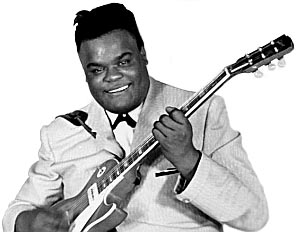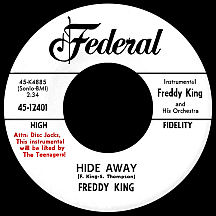FREDDY KING
Hide Away
The "Kings" of electric blues guitar, while unrelated by blood, share a common bond. Saunders King was among the earliest to find success exhibiting electric six-string procedure when his recording of "S.K. Blues" attracted considerable attention in 1942. B.B. King arrived in the late '40s and needs no introduction, nor does "Lucille," his famously-named guitar. Earl (Johnson) King made a mark on the public in 1955 with his first hit, "Those Lonely, Lonely Nights." Albert King came along in the early '50s, but didn't start scoring hits until 1961. Southerners all, each made his mark as a more amped-up brand of blues-style guitar playing persistently gained more notice. I'm sure there are others named King who might deserve a spot on this short list of innovative bluesmen, but only one other would be able to claim a significant level of national success prior to the early 1960s. Freddy King was the youngest of the bunch; he hailed from a place a little to the west of the others in the Lone Star state and, while B.B.'s half-century-plus career ultimately reached spectacular levels, a case can be made for the more immediate influence Freddy had on the rock guitarists who set the trends of the '60s and the decade that followed. His singularly dynamic axe-handling technique was imitated by future trendsetters almost immediately after he began getting widespread radio airplay in 1961.
Born in 1934 in the East Texas town of Gilmer, he should have been named Fred Christian after his father, J.T. Christian, but ended up with the surname of his mother, Ella Mae King. His interest in the guitar began around age six; blues great Lightnin' Hopkins was a favorite during his teens. His mother and her new husband moved the family to Chicago in 1949 and "Freddy" became a married man at age 18, around the time he began offsetting his new job at a steel mill with nightclub gigs. Plugged-in blues guitarists Jimmy Rogers and Eddie Taylor joined their friend to form a short-lived band, The Every Hour Blues Boys. Occasionally working sessions for the Chicago-based Parrot Records, Freddy's guitar licks (he had several Gibson and Les Paul models) enhanced a number of mid-'50s recordings for the label.
Finally, Freddy made the first record under his own name for the El-Bee label in 1956. "Country Boy," an easygoing blues number, featured Margaret Whitfield (doing a "country girl" counterpart) and gave King the confidence to audition for Chess Records, where many of the Chi-Town artists he regularly crossed paths with were already finding success. Continued attempts over the next few years got him nowhere (though partner Rogers made the grade and even had a hit on Chess, "Walking By Myself," in 1957). While playing at a South Side lounge called Mel's Hideaway, he met Sonny Thompson (a versatile pianist, his best-known hits, instrumentals "Long Gone" and "Late Freight," had topped the R&B charts in 1948), who took him to King Records in Cincinnati, Ohio. Owner Syd Nathan dug the sound and Freddy fit right in, signing a contract in 1960...and that seemed logical, considering his regal name...but Nathan put him on the company's Federal label anyway.
In August, Sonny, Freddy and singer Otis "Smokey" Smothers headed to Cincy to lay down some sides. Freddy's Federal debut, "You've Got to Love Her With a Feeling," surprised many outside the big man's Windy City circle of friends and clubgoers...guess they didn't anticipate such killer fret-fingering and a well-honed vocal approach that belied King's 26 years. The single managed a brief appearance on the national charts in January '61 (the very next release from the session was "What Am I Going to Do," featuring King on guitar, Smokey Smothers' first of eight singles for the label). The proposed B side of Freddy's follow-up single was a hit...his biggest! "Hide Away," quite possibly the hottest jam of the year by anyone, showed off sundry pickin' tricks including riffs lifted from Jimmy McCracklin's 1958 hit "The Walk" and Henry Mancini's "Peter Gunn" TV theme from the same year (the latter channeled, perhaps, through Duane Eddy's version from '60). The single reached the pop top 30 and R&B top five that spring. Its influence would be felt for a very long time.
It was a great year for the innately talented guitarist as he placed seven songs on the charts, most of which he and Sonny Thompson composed, together and separately. The one exception was "Lonesome Whistle Blues," a Rudy Toombs-Elson Teat-Alan Moore song that electrified listeners through King's playing and vocals. Next came summer hit "San-Ho-Zay," a hot instrumental tribute to the California city, provided residents didn't mind a little misspelling via "artistic license." "I'm Tore Down" ('...I'm almost level with the ground!') and "San" flip "See See Baby," standard lyrics and strong vocals with smoking arrangements, kept the streak going. "Christmas Tears," a holiday depression tale, closed the season in the R&B top 30. A series of enjoyable instrumentals appeared over the next few years with titles like "Heads Up," "The Stumble," "Side Tracked" and "Texas Oil" before he fell back on "Hide Away"-type riffs on tracks like "King-A-Ling." These were interspersed with vocal efforts including a few duets with longtime King-Federal diva Lulu Reed.

Next to music, partying was King's thing. Middle-of-the-night drinking and gambling binges (not to mention eating) reached the breaking point around 1962 for his wife, who packed up the kids (six of 'em) and moved to Dallas, Texas. Freddy joined them several months later and, at least for a time, made an earnest attempt at being a responsible husband and father. But he hadn't yet realized a movement was brewing among younger rock musicians, first in England and then in the U.S. Eric Clapton, for one, considered King his main man and recorded "Hide Away" for the John Mayall album Blues Breakers...and just like Freddy King had done with McCracklin and Eddy, Clapton "borrowed" a little piece of B.B. King's "Please Love Me" (but then - who didn't?) on his version, doing his part to spread the word about the blues to any rock-obsessed devotees anxious to arrive at the next level.
Around this time, Freddy parted ways with King-Federal and after a year or so on the cirucit he crossed paths with another (distant!) family member, sax master King Curtis, who helped him arrange a deal with Atlantic Records; two singles and two albums on Cotillion hit stores in '69 and '70. Concert tours began consuming his time while fattening his pocketbook (and, well, his body, too) as he shared stages with the likes of Led Zeppelin, Clapton and brother-in-blues B.B. King. Another musician-fan, Leon Russell, signed him to his Shelter label about the time he changed the spelling of his first name to Freddie and a nickname, "The Texas Cannonball," took hold. Grand Funk Railroad, one of the bands he toured with, revealed one of King's vices on their number one hit from '73, "We're An American Band," which contained the lyrics 'Up all night with Freddie King...I got ta tell ya, poker's his thing...'
Having forged a close friendship with Clapton, it seemed inevitable they would make records for the same label; Freddie joined RSO (where Eric had many hits) and demonstrated a heightened vocal power on tracks like "My Credit Didn't Go Through" that at times was on par with his magnificent musicianship. You wouldn't have guessed that his health was sinking fast: food and drink in excess, a weight problem that put him close to 300 pounds and an ulcer that ultimately did him in. He lived large and paid the price, but his influence had already been noted. Freddie King's recordings are easy to find...and the effect he had on thousands of admiring rock guitarists is hard to miss.


